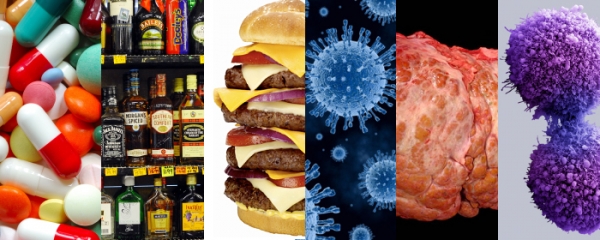6 things that can harm your liver

To protect our liver, we first need to know what harms our liver. We all know that alcohol can harm our liver, but what other dangers are there?
The liver is involved in many critical functions that keep us healthy. Learn more about the things that can cause damage and help your liver to guard your health.
Medication
All medication are processed by the liver and can potentially harm it. During the process, the medication undergoes chemical changes. While the original product might not be harmful, the resulting by-products may be toxic to the liver. Sometimes, the interaction of different medications, or when combined with alcohol, may cause life-threatening complications. [1]
Overdose or long term medication may cause hepatotoxicity, which means chemical-driven liver damage. If taken in the long term, some drugs or chemicals can induce chronic hepatitis or even cirrhosis. [2] So it is important to read the information leaflet before use. Learn how the medicines you take might affect your liver and take the medications as directed. [3]
Alcohol
Heavy alcohol consumption is one of the most common causes of liver damage. When you drink alcohol, the liver works overtime to convert ethanol into a less toxic form which we eventually release as urine. This means that the liver gets diverted from its other primary functions and focuses mainly on converting alcohol.
Excess alcohol intake can also cause fat to build up in your liver. The fat deposited due to absorption of alcohol can cause fatty liver disease. It also causes inflammation of the liver which leads to alcoholic hepatitis and may progress to cirrhosis after many years of heavy drinking. [4]
Fat
The liver normally helps to process and regulate the amount of sugar and fat in the blood. But when the liver becomes overwhelmed, it starts storing excess fat in its own liver cells, causing non-alcoholic fatty liver disease (NAFLD).
If too much fat builds up, or if certain genetic conditions are present, the fatty liver tissue can become inflamed and the liver cells can be damaged or destroyed. This is called non-alcoholic steatohepatitis (NASH). If the inflammation persists, it may lead to cirrhosis of the liver and liver failure. [5]
Hepatitis virus
Hepatitis is an inflammation of the liver and can have many different causes. Viral hepatitis is the most common cause of hepatitis worldwide.
There are 5 main hepatitis viruses, types A through E. Hepatitis B (HBV) and hepatitis C (HCV) are the most common viral hepatitis. The virus attack the liver cells, causing inflammation. If the liver inflammation last less than six months, it is considered acute hepatitis; if the disease course becomes longer than six months, the liver inflammation is chronic. Chronic viral hepatitis may advance to cirrhosis and liver failure. [6]
Fibrosis
Fibrosis is the accumulation of scar tissue in the liver. Over time this process can result in cirrhosis of the liver.
Chronic infection with HCV or HBV, heavy alcohol consumption, toxins, or trauma can all lead to liver fibrosis, but sometimes the cause is unknown. When liver cells are injured due to a virus, alcohol, toxins, trauma or other factors, the immune system tries to repair the damage. During the process, scar tissue builds up and may eventually affect liver function. [7]
Cancer
There are two types of liver cancer. Primary liver cancer is cancer that starts in liver cells. Apart from this, the liver can also be affected by cancer which was formed in another part of the body and spread to the liver. This type of cancer is called secondary or metastatic liver cancer. Almost any cancer can spread to the liver, but the most common ones include bowel, lung and breast cancer. Since all the blood in the body passes through the liver, it becomes a likely place for the cancer cells that have escaped into the bloodstream to settle. [8]
- Medication Safety. (n.d.). Retrieved from http://www.liver.ca/liver-health/liver-disease-prevention/tips-for-healthy-liver/drug-safety.aspx (accessed 18/9/2015)
- Toxic Hepatitis. (n.d.). Retrieved from http://www.liver.ca/liver-disease/types/toxic-hepatitis.aspx (accessed 18/9/2015)
- Managing Your Medications. (14 January, 2015). Retrieved from http://www.liverfoundation.org/mym (accessed 18/9/2015)
- Why is alcohol bad news for your liver? (24 July, 2015). Retrieved from http://www.thehealthsite.com/diseases-conditions/why-is-alcohol-bad-for-your-liver/ (accessed 18/9/2015)
- 5 Common Habits That Damage Your Liver. (3 October, 2014). Retrieved from http://www.healthyandnaturalworld.com/common-habits-that-damage-your-liver/ (accessed18/9/2015)
- What is hepatitis? (n.d.). Retrieved from http://www.who.int/features/qa/76/en/ (accessed 18/9/2015)
- Liver Fibrosis. (n.d.). Retrieved from http://www.liversupport.com/liver-fibrosis/what-causes-liver-fibrosis/ (accessed 18/9/2015)
- Cancer Fact Sheets – Liver Cancer. (n.d.). Retrieved from http://www.cancer-fund.org/en/liver-cancer.html (accessed 18/9/2015)
- * All research and clinical data should be used as reference purposes only, results may vary.






